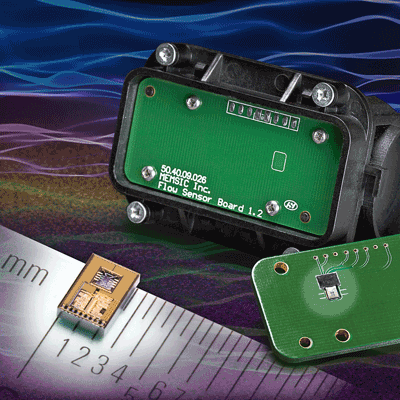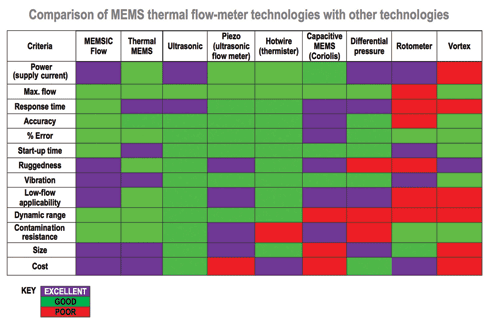Having proven their worth for accelerometer applications, MEMS sensors are also tackling gas-flow measurement
BY YONGYAO CAI
Director of Engineering
MEMSIC
www.memsic.com
Like piezoresistive, piezoelectric, and capacitive sensing techniques devices, sensors based on thermal microelectromechanical systems (MEMS) have enabled motion sensing in accelerometers. These thermal sensors are less expensive, more reliable, more accurate, and smaller than competitive approaches. Even though capacitive accelerometers can be manufactured on a MEMS process, they suffer from much lower shock survivability and reliability than thermal MEMS types, as do piezoresistive accelerometers.
Moreover, capacitive MEMS accelerometers feature higher offset temperature coefficients, higher offset drifts, higher levels of hysteresis, are relatively more costly, and are generally larger in package size.
Thus thermal MEMS sensors have clearly proven their worth for accelerometer applications. However, the principle of thermal sensing can also be used for gas-flow measurements. The MEMSIC MFA1100R gas-flow sensor' (Fig. 1 ) uses the same thermal principle of operation as MEMSIC's thermal accelerometer, providing much the same proven benefits over other types of gas-flow senosrs.

Fig. 1: The MFA1100R thermal gas-flow sensor module integrates the sensing element with on-chip signal-processing and software on a monolithic CMOS process.
Broad application
The need for gas-flow measurement is wide-spread. In the medical market, gas-flow measurements are critical in anesthesia delivery, chromatography, sleep apnea, spirometers, and ventilators. In the industrial sector, gas-flow measurement is needed for heating, ventilating and cooling (HVAC) systems and fume hoods. Analytical instruments, fuel cells and turbines also rely on accurate and rapid gas-flow measurements. Such capabilities have been commercially available in the last few years, but until now have been relatively costly, bulky, and available from a limited number of suppliers. A huge application is in accurately measuring natural gas in the residential market.
Recently a number of companies have entered the market with MEMS mass gas-flow thermal sensors that are less costly and feature decent to good levels of performance. However, the principles employed to realize these sensors differ widely, and affect one or more important performance parameters such as size, cost, dynamic range, flow rates, and susceptibility to vibration.
Not all thermal flow meters are alike. Some thermal flow meters may achieve accuracy levels of 1%. However others have accuracies in the 3 to 5% range. A comparison of MEMS thermal flow-meter technologies with other technologies illustrates that MEMS thermal gas-flow technology is superior in six key areas: accuracy, dynamic measurement range, size, cost, power dissipation, and ruggedness (see Table).

There are several different thermal flow-meter technologies. Some measure the speed of the gas flow as heat that is added to the flow stream disperses and are also known as thermal dispersion flow meters. Others measure the temperature difference between a heated sensor and the ambient flow stream.
Thermal mass flow meters have several major advantages. They're relatively inexpensive and can measure the flow of some low-pressure gases that are not dense enough for Coriolis meters to measure. Both of these advantages give thermal flow meters their own unique niche in gas-flow measurement. They also allow for the monitoring of a one or more of the thermal characteristics (temperature, thermal conductivity, and /or specific heat) of a gaseous media to define the mass flow rate. But they have limitations, namely most of the gases they can measure accurately must be fairly clean and non-corrosive.
Underlying technologies
Let's examine several of the major types of gas-flow meter technologies currently being employed. The most common is the diaphragm/bellows type of meter used in residential locations and is over 100 years old. It measures the volume of the gas used. However, it is highly affected by temperature, pressure and humidity levels and heating-value compensation is required to measure the actual amount and value of the gas moving through the meter.
A Coriolis gas-flow meter consists of one or more pipes with longitudinally or axially displaced section(s) that are excited to vibrate at resonant frequency. When the gas within the displaced section is at rest, both the upstream and downstream portion of the displaced section will vibrate in phase with each other. The frequency of this vibration is determined by the overall density of the pipe (including its contents). This allows the meter to measure the flowing density of the gas in real time.
Once the gas begins to flow, however, the Coriolis effect comes into play. This effect implies a relationship between the phase difference in the vibration of the upstream and downstream sections and the mass flow rate of the fluid contained by the pipe.
Coriolis meters have a high initial cost. Furthermore, they become expensive and unwieldy in line sizes above 4 inches although more recently line sizes have increased up to 12 to 14 inches.
A thermistor, also known as a hot-wire anemometer, is basically a resistor thermometer or a temperature-sensitive resistor. Thermistors are fragile devices and are susceptible to breakage and dirt. This makes them unsuitable for gas-flow temperature measurements.
Ultrasonic flow meters sense gas flow by operating on two basic principles: transit time or time-of-flight and Doppler shift. The former type is the most common.
In the time-of-flight configuration, a pair of transmitters/detectors is placed at a distance apart inside the gas flow channel, close to the channel wall in most cases. The time difference between the signal transmitted from up- to down-stream and the one from down- to up-stream is proportional to the gas flow rate.
With the Doppler shift principle, an ultrasonic signal is transmitted across the flow channel and is deflected by the particles inside the flow stream. The measured Doppler frequency shift is proportional to the flow speed of the particles that are traveling at the same speed along with the flow stream.
Multipath ultrasonic sensing is often used for natural gas flow measurement where multiple pairs of ultrasonic transducers are used in the same gas pipeline. Data obtained from these transducers is averaged to enhance measurement accuracy.
Ultrasonic gas flow sensing is comparatively costly. It also requires use of temperature and pressure sensors to compensate for environmental temperature and pressure changes.
Into the vortex
A vortex-shedding flow meter makes use of a physical principle involving the formation of vortex swirls (vortices) downstream of an obstruction placed in a flowing stream. This is a bluff body that's called a shedder bar.
Vortex flow meters are extremely versatile for measuring gases, liquids and steam. They're also reliable since they have no moving parts and feature relatively high accuracy. However, the presence of a bluff body in the stream of the gas or liquid flow may cause some drop in pressure of the medium being measured.
Gas flow measurements can also be made using the turbine flow meter, also known as an axial turbine meter. It translates the mechanical action of the turbine rotating in the gas flow around an axis into a user-readable rate of flow. The turbine tends to have all the flow traveling around it.
The advantage of this type of measurement is higher flow rates and less pressure loss than other approaches. Their disadvantage is that they are less accurate at low flow rates.
Another common gas-flow measurement meter is a rotameter, part of a class called variable area meters. It measures the flow rate of liquid or gas in a closed tube. Flow rate is measured by allowing the cross-sectional area the fluid travels through to vary, causing some measurable effect.
Several types of flow meters that rely on Bernoulli's principle, either by measuring the differential pressure within a constriction, or by measuring static and stagnation pressures to derive the dynamic pressure. These include the Venturi meter, the orifice plate the Dall tube, the Pitot tube and a multi-hole pressure probe.
Digital trends
In summary, the trend in gas-flow measurement technology is being helped by monolithic IC developments, particularly thermal-flow MEMS, enabling smaller, faster and cheaper flow sensors. This in turn is making sensor gas flow meters more modular and easier to interface with computers and transmission facilities, thus keeping up with a more efficient and modern digital world.
Thermal MEMS gas-flow technology is proving its mettle in meeting residential, commercial, and industrial measurement needs. They're making their application more affordable, more flexible, and easier to use. ■
Advertisement
Learn more about MEMSIC





